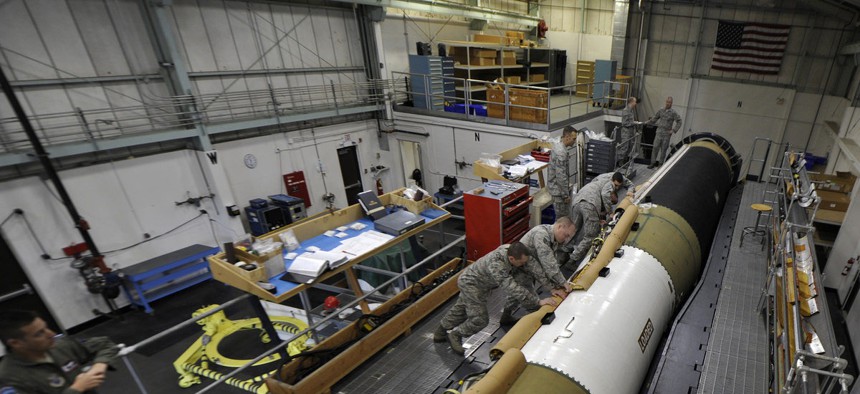
Airmen working on a Minuteman III ICBM at Vandenberg Air Force Base, Calif. U.S. Air Force photo by Staff Sgt. Jonathan Snyder
The End of the New ICBM
Facing enormous cost estimates, advocates for the nuclear triad just threw in the towel on building a new intercontinental ballistic missile. By Stephen Young
Last week, at a conference full of advocates for modernizing the United States’ nuclear triad, something big happened: the idea of developing a new, nuclear-armed, ground-based long-range missile fell off the table.
The nuclear triad -- missiles, bombers and submarines that can deliver nuclear weapons -- is under fire from all sides, as that force needs upgrading right when there is little budget or public appetite to do so. The Air Force is considering options for replacing or extending the life of the Minuteman III missile, or what it calls the ground-based strategic deterrent. Currently 450 of these weapons, most armed with a single nuclear warhead, are located in underground silos at three bases spread across North Dakota, Montana, Wyoming, Colorado and Nebraska. Programs are in place to ensure that the Minuteman can stay in service at least until 2030. Last January, the Air Force announced it was considering several options to replace Minuteman, including new, silo-based and mobile missiles on trucks or in an underground rail-based approach similar to a subway system.
But a major blow to developing a new missile came on February 4, with the publication of an Air Force-funded RAND study. That detailed analysis found that an “all-new ICBM system will likely cost almost twice (and perhaps even three times) as much as incremental modernization and sustainment of the MM III system.” Specifically, RAND estimated that the lifecycle costs for incrementally modernizing the Minuteman III would be $60 to $90 billion, while a new silo-based ICBM would cost between $84 billion and $125 billion. Rail- and road-mobile versions would cost significantly more, from $124 billion to $219 billion.
The impact of that study was felt at last week’s three-day Nuclear Deterrence Summit, organized by Nuclear Weapons & Materials Monitor. The conference is a veritable who’s who of triad aficionados and the message was clear: maintain the triad, but at an affordable cost. Maj. Gen. Garrett Harencak, assistant chief of staff for strategic deterrence and nuclear integration, who is responsible for the Air Force’s nuclear deterrence operations, argued that it was long past time for the U.S. to make the significant investments that will be required to recapitalize the strategic triad of delivery vehicles and the nuclear devices they carry. He appealed to the audience for a “glide path” -- military speak for a sensible and gradual plan -- that would maintain U.S. nuclear forces without breaking the bank. Harencak acknowledged that alternative ICBM proposals like the rail-mobile approach had come under ridicule, arguing that the analysis was simply a study of possible options, nothing more. He also recognized that in the current budget environment it would not be possible for the U.S. to replace every system developed during the Cold War.
Later, Amb. Linton Brooks, who negotiated the first START arms control agreement for President George H.W. Bush and later headed the National Nuclear Security Administration, said that there was no reason to consider a new ICBM at this time. Further extending the life of the Minuteman beyond 2030 was not only feasible but eminently sensible. And Peter Huessy, who for decades has organized an Air Force Association lecture series for Congressional members and staff, argued that simply extending the life of the Minuteman III would save some $30 billion over a new ICBM.
With that, the case was closed. In the current budget environment, the outcome is inevitable. The Air Force will not build a new ICBM. The new question: When it becomes necessary to extend the life of the Minuteman, will the missile still be required?
CORRECTION: This article was updated to accurately state that Air Force announcement to consider options to replace the Minutemen was made in January 2013, not March.
Stephen Young is senior analyst at Union of Concerned Scientists.
NEXT STORY: Hackers Target VFW Website





